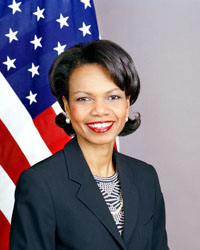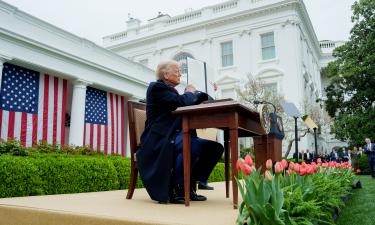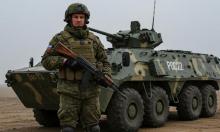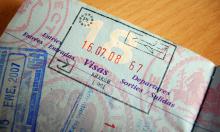Condoleezza Rice to beat Angelina Jolie in popularity
When Russian diplomat Sergei Lavrov was arguing with US Secretary of State Condoleezza Rice over business lunch, he hadn’t even a thought that most American men would have paid a very high price to be in his place.

The picture of the hard-working secretary of state on the move appears to be integral to her growing clout and her status as the most popular Cabinet member in a beleaguered administration.
Rice's job-approval rating in a Harris survey last month was 20 percentage points higher than that of President Bush. A Washington Post poll of 1,000 adults conducted last month suggests that public appeal is based on both a reputation for professionalism and an ability to avoid being identified with the administration's most unpopular decisions. Although she was Bush's national security adviser during the Iraq invasion, a large percentage of those surveyed - including opponents of the war - say she had little or nothing to do with the problems in Iraq.
Rice's celebrity overseas may be even more pronounced than in the United States, making her a truly global figure. In Kiev last December, for instance, university students sat rapt as Rice answered questions about her "recipe for success" and what it meant to be the "most influential woman" working for Bush. On a trip to Baghdad in April, Abdul Aziz al-Hakim, head of the Supreme Council for the Islamic Revolution in Iraq, the largest Shiite political party, pulled Rice aside to ask if she would write a note to his granddaughter.
Esquire magazine, for its July issue, asked more than 1,000 men to choose among 14 notable women who they would most want to attend a dinner party. Rice placed first, ahead of Oprah Winfrey, Angelina Jolie, Julia Roberts and Jennifer Aniston. Rice told the Greensboro (N.C.) News & Record that she was stunned at the result. "I'm not sure I would choose me," she said.
In the Post survey, twice as many people had a favorable opinion about Rice as viewed her unfavorably, while other recent surveys have found that majorities of Americans have negative impressions of Bush and Vice President Cheney. Of those who have a favorable view of Rice, a majority said it was mostly because of her professional abilities, rather than the policies she supported.
This impression extended to Democrats and independents interviewed; more than seven of 10 cited either Rice's professional abilities or her personal qualities as the reason for their favorable impression.
These positive impressions have made Rice a viable contender in the 2008 presidential race, though she routinely tries to play down speculation that she would consider running. In the Post survey, 54 percent said they would either definitely vote for her or consider voting for her.
Without encouragement from Rice, grass-roots campaigns have sprung up to encourage her to run, though she insists she wants to return to California and teaching.
Rice's high public standing in the face of the administration's problems has been a source of pride for her staff, but officials declined to cooperate in the preparation of this article. State Department spokesman Sean McCormack would not comment.
As national security adviser, Rice appeared frequently on television as an occasionally stiff defender of the president's policies. But she appeared to achieve stardom early in her tenure as secretary of state when, a month after taking the post, she was photographed walking past hundreds of cheering soldiers in Germany wearing a black skirt, a black coat and knee-high black boots that evoked the movie "The Matrix." Rice routinely wears expensive and flashy designer outfits in her travels.
Rice is especially effective in town-hall-style meetings in which she engages in extended give-and-take with the audience. She still delivers many of her speeches in the pedantic style of a former university professor, but her staff has learned to keep thespeeches relatively short (about20 minutes) so she can then take questions for 40 minutes.
Overseas, Rice uses her personal story of growing up in the segregated South to demonstrate humility about the American experience. She will frequently note that "my ancestors in Mr. Jefferson's Constitution were three-fifths of a man." In Sydney earlier this year, there was an audible gasp from the nearly all-white crowd when she said she did not have a white classmate until she moved to Denver in 10th grade.
Rice combines her personal touch with an unusually close relationship with the president. She was extraordinarily close to Bush as national security adviser and still speaks to him at least once a day, if not more.
Rice's predecessor, Colin L. Powell, was personally popular from his previous role as chairman of the Joint Chiefs of Staff, but he did not have a close partnership with Bush, and as secretary he did not have a feel for visual flair.
Rice has traveled about 490,000 miles in the 17 months since becoming secretary -- it took Powell twice as long to compile such mileage -- including a 31,000-mile slog through Latin America and Asia that appears to be the longest single trip ever made by a secretary of state.
But Rice has combined the travel with an unusual attention to visual detail, intended to show viewers at home that she is working and those overseas that she cares about their cultural traditions.
To highlight a new effort to reach out to Europe after the tensions of the Iraq invasion, Rice combined a groundbreaking speech in Paris -- at the alma mater of French President Jacques Chirac -- with a visit to the Hector Berlioz Conservatory. The local news media avidly covered her as she watched children perform. A trip to India included a stop at a cultural icon, Humayun's Tomb in New Delhi, which resulted in coverage across South Asia and large photo displays in U.S. newspapers.
Rice's trips have included photos of her watching potential Chinese Olympians ice skating in Beijing, visiting a top-secret facility carved into a mountain near Seoul that would direct a war with North Korea and awarding the medals for the women's breaststroke competition (an Australian specialty) during the Commonwealth Games in Melbourne, Australia.
"The day-to-day of diplomacy is not important to people," said James B. Steinberg, dean of the LBJ School of Public Affairs at the University of Texas and a State Department and White House official in the Clinton administration. But such images are effective because ordinary Americans "find it appealing. They can relate to it more than pictures of people in suits going to meetings."
Rice has added an unusual innovation, at the urging of former senior adviser Jim Wilkinson: cultural airport greeters. Instead of being met by protocol chiefs or foreign ministers, Rice's office has requested that the secretary be met by a country's pop culture heroes, especially sports or music stars, guaranteeing extensive coverage by the local media. Because Rice tends to arrive at night, this also ensures that she is already on the front page of the morning newspapers when she arrives for meetings with top officials.
In Tokyo, Rice was met at the airport by Konishiki, a sumo champion. A photo of the 600-pound wrestler hugging the much smaller Rice even appeared on the front page of the Financial Times.
In Romania, she was met by Olympic legend Nadia Comaneci, young Romanian Olympic gymnasts and Special Olympians. And in Belgium, the media widely covered her meeting with cyclist Eddy Merckx, who won the Tour de France five times.
She has also met with musical heroes, such as in Seoul, when she was greeted by both a matronly singer of traditional Korean music and a young pop star in baggy, ripped jeans.
Source: The Washington Post
Prepared by Alexander Timoshik
Pravda.ru
Discuss this article on Pravda.ru English Forum
Subscribe to Pravda.Ru Telegram channel, Facebook, RSS!





